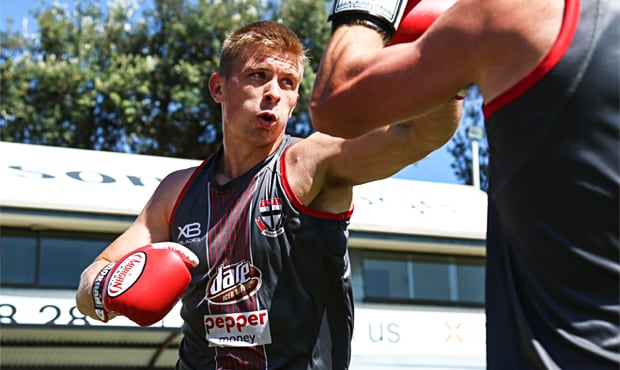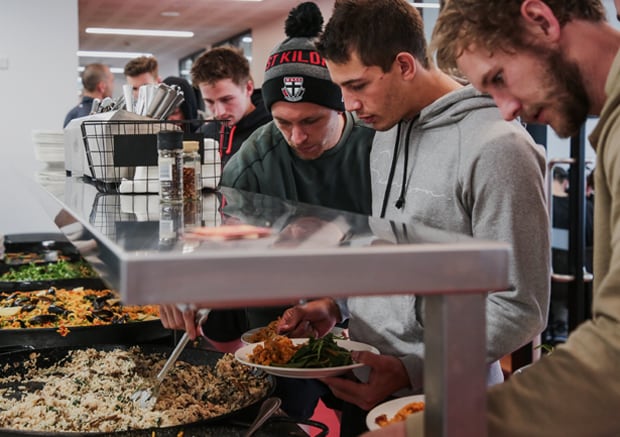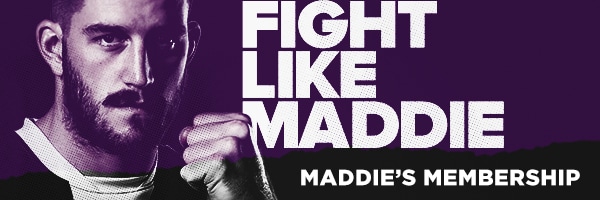It’s well-known that St Kilda’s star midfielder Seb Ross is the pinnacle of professionalism at the Saints.
He is disciplined and mature, he takes enormous pride in his physical and mental preparation, and his incredible work ethic makes him a natural leader
It was unusual then, that no matter how hard he tried, Ross couldn’t manage to keep his skin fold test results where he wanted them.
“It’s always been a struggle for me, getting the skin folds in order, but I think there’s a group of us that struggle with it … we generally put it down to genetics,” he laughed.
“There’s plenty of guys that you watch eat and you live with, and you watch them put whatever they want in their mouth and they come and get their skin folds and they’re lean and
WATCH: Round 15 Highlights v Melbourne
Eventually, Ross had had enough, and in the 2018 pre-season, the 25-year-old midfielder sought the assistance of St Kilda Dietitian Alison Miles.
“I went and approached Ali about it because I was getting sick of getting to my exit interviews every year and the coaches hitting me up about my skin folds when I was always really trying to do the right thing,” Ross told saints.com.au.
Miles’ resumé boasts working with Australia’s Winter Olympic team and athletes at the Victorian Institute of Sport, but she said identifying issues with an athlete’s nutrition is not always as clear-cut as it might seem.
“When someone is carrying extra body fat, the initial thought is that they’re eating the wrong types of things at the wrong time,” she said.
“But with Seb,

Seb Ross is the pinnacle of professionalism at the Saints.
Seb is renowned for his discipline and diligence, and something just didn’t add up.
“There was just such a discrepancy between what he was doing in terms of his training and nutrition, and still not being able to get his skin folds down.”
“This is an elite athlete trying desperately to do the right thing and being so diligent with his intake. He was trying so hard that he was actually under-eating and under-fuelling.”
Miles has dealt with similar cases in the past, where an athlete’s diet is so rigid and low in calories that their body enters a “starvation mode”.
“It’s really about that whole caveman concept of ‘feast vs famine’,” she said.
“If there’s no food around, mother nature will want you to survive until there’s food again, so your body will naturally slow down its rate of metabolism, almost like a bear in hibernation.”
READ: Ross and Steven a cut above
Miles suggested that Ross undergo a Resting Metabolic Rate (RMR) test to analyse his energy output, which would reveal how fast his body could use up calories.
His results showed that he had a suppressed metabolism, so his body was effectively in starvation mode and
“Seb’s RMR was really low, so from that, he needed to increase his food intake. He needed to send a really strong message to his body to say that, ‘Hey, we’re not in a time of famine anymore’,” Miles said.
“It’s not just adding a heap of extra calories, it’s about being smart with where you’re adding them.
“It took a little bit of time to implement, and I took some advice from Bronwen Lundy, who’s the head dietitian at Rowing Australia up at the AIS in Canberra, and she said, ‘Be prepared that he may even gain a little bit of body fat’.”

Seb Ross had to massively increase his food intake to kick-start his metabolism.
With his new increased dietary requirements, Ross endured what was at times an uncomfortable pre-season training regime.
“As an athlete, you get a bit scared of carbs and all that sort of stuff, so it was a really interesting pre-season for
“I actually found it hard, which made sense to Ali because I do have a suppressed metabolism. I probably get fuller quicker, so I sort of had to force-feed there for a bit, but it’s sort of slowly started to turn the wheel.”
As expected, the 2017 Trevor Barker Award winner watched his
“Seb’s eating more than he ever has, and his body composition is improving by the week,” Miles said.
Seb Ross is feeling fitter and leaner than he has before as an AFL player, and he credits his improved physical state to the huge influence Miles has had on his diet and sculping it to suit him.
“It speaks to the importance of having a dietitian at the club,” Miles said.
“Whereas someone untrained would look to cut down an athlete’s diet further, a dietitian’s understanding of the science behind the food means we can offer relevant advice and make adjustments.”
Ross has consistently featured in the Saints’ leading ball-winners in 2018 and is firmly in the hunt to win the club’s highest individual honour for the second year in a row.
Listen to Seb Ross on Behind the Crest below.



